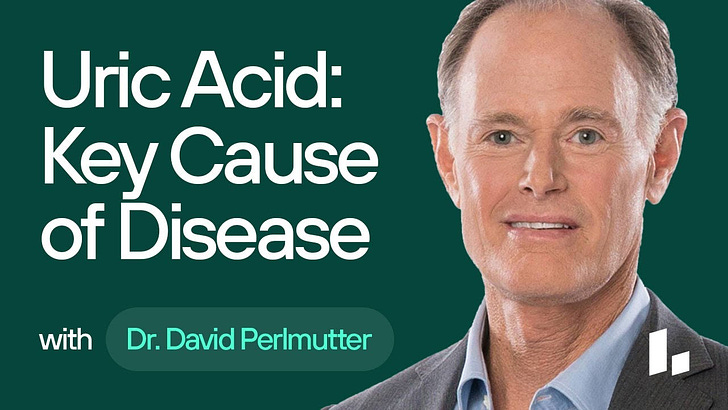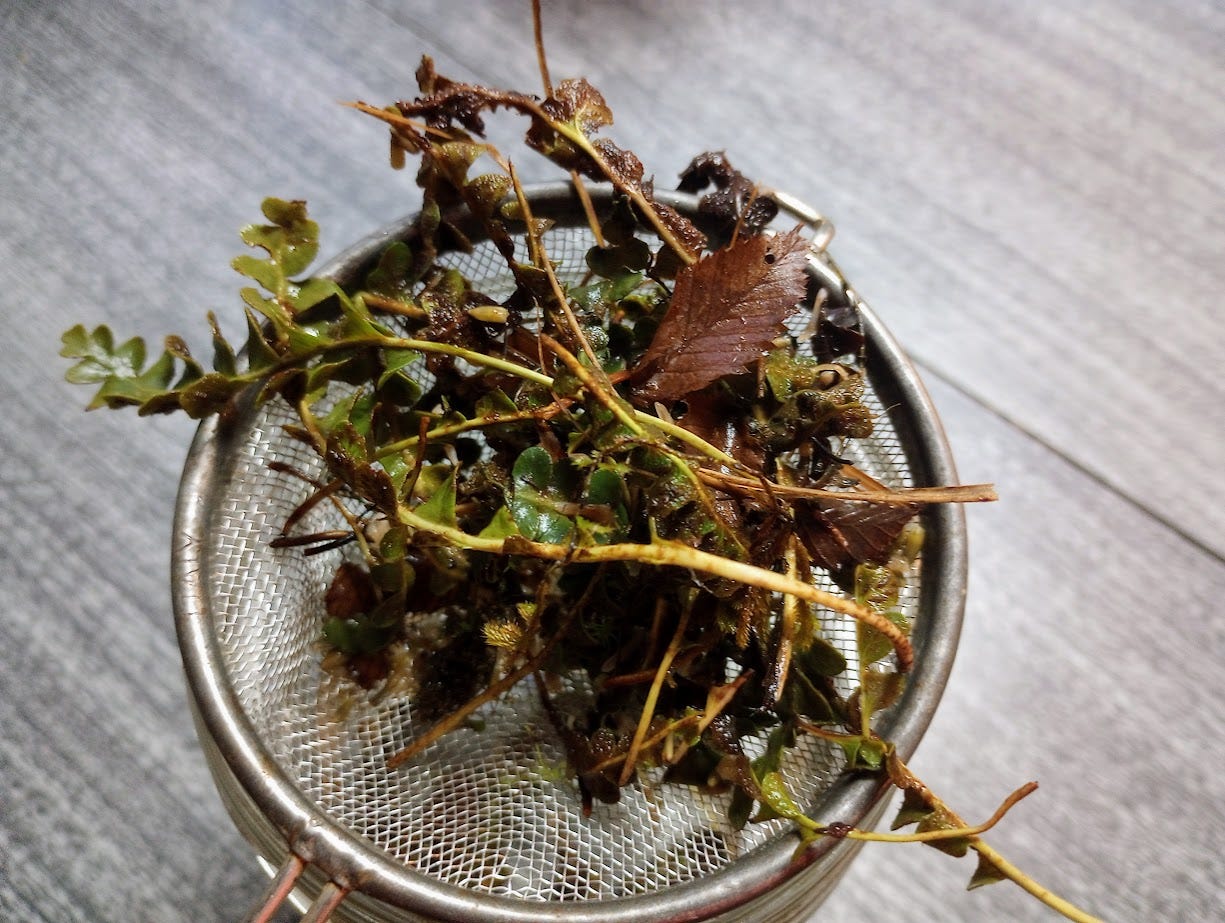Uric Acid negatives & things that might help - videos by Dr. Perlmutter and Dr Kim, a TCM holistic foot doctor. Uric acid can cause gout and toe pain.
Aids include: astaxanthin, Rustyback fern, and our favorites quercetin, luteolin and vitamin C, and celery is a good source of luteolin and promotes detoxification.
An interview with Dr. Perlmutter has a warning about the cardiometabolic health risks of uric acid levels above 5.5. Lab guidelines consider above 7 to be elevated and a risk for gout but other health risks start occurring above at levels of uric acid above 5.5.
Sources of uric acid from the diet can be from a high fruit sugar intake or a high intake of meats and vegetables that are rich in purines. Purine rich meats include organ meats and small fish like anchovies, mackerel and sardines.
Health within the body can be the bigger problem as 2/3 of the uric acid in our body is from production in the liver and only 1/3 is from dietary sources. TCM calls this a Wind Pain problem and it can be very painful according to Dr. Kim, a holistic foot doctor with roots in TCM. Our hands and feet suffer the joint pain most from crystallized uric acid because of the slightly cooler temperature in our extremities. Purines are a byproduct of DNA and RNA breakdown and when purines breakdown they turn into uric acid. When we are unhealthy there is likely to be an increase in breakdown of protein and DNA which leads to an increase in uric acid. Obesity is also associated with elevated uric acid. (Youtube)
Alkalizing the body is the solution. Over acidity within the body reduces excretion of uric acid in the kidneys.
FINALLY Experience FOOD FREEDOM From Gout Attacks... The REAL Cause Revealed!, Dr. Kim, America's Holistic Foot Doctor, (Youtube)
(Relief Fast) 6 Home Remedies For Gout!, Dr. Kim, America's Holistic Foot Doctor, (Youtube)
Quercetin intake would be protective, helping to break down and excrete uric acid, (500 mg/day). Luteolin, 100 mg/day may also help. Vitamin C can also help with excretion of uric acid (500 mg/day) (*but is an acid so overdosing would add to an acidic body problem).
Uric Acid: A KEY Cause of Weight Gain, Diabetes, Heart Disease & Dementia | Dr. David Perlmutter, Interview by Levels Chief Medical Officer, Dr. Casey Means, (Youtube)
Another video on the topic on Dr. Perlmutter’s channel;
Uric Acid - The Acid You May Need to Drop - with Dr. Johnson, [a nephrologist] | The Empowering Neurologist EP. 138 (Youtube).
Purine Rich Foods (on a page about gout)
“Limit very high-purine foods, including:
Organ meats, such as liver, kidneys, sweetbreads, and brains.
Meats, including bacon, beef, pork, and lamb.
Game meats and any other meats in large amounts.
Anchovies, sardines, herring, mackerel, and scallops.
Gravy.
Alcohol, especially beer and hard liquor.”
You can eat certain foods that are medium-high in purines, but eat them only once in a while. These foods include:
Legumes, such as dried beans and dried peas.
Asparagus, cauliflower, spinach, mushrooms, and green peas.
Fish and seafood (other than very high-purine seafood).
Oatmeal, wheat bran, and wheat germ.” (myhealth.alberta.ca)
That will be tough on a vegan diet…
The safer/low level of purine list includes fruit, but Dr. Perlmetter is recommending to limit fruit sugar, so I will rely on his analysis of the health risks of elevated uric acid. *One of my elevated labs recently was a uric acid level above 7 (but below 8, it was 7.4 maybe).
I can’t eat eggs or dairy products either - I do like eating nuts as long as I reduce the oxalate load. Presoaking an extended time makes it easy to remove the peels on almonds. That is reducing the phytic acid and the oxalate content.
“Plan your meals and snacks around foods that are low in purines and are safe for you to eat. These foods include:
Green vegetables and tomatoes.
Fruits.
Whole-grain breads, rice, and cereals.
Eggs, peanut butter and nuts.
Low-fat cheese, milk, and milk products.
Popcorn.
Gelatin desserts, chocolate, cocoa, cakes and sweets in moderation.” (myhealth.alberta.ca)
Other articles on the topic of a uric acid reducing diet:
Dt. Neha Suryawanshi, Diet For High Uric Acid Levels - Eat & Avoid 15 Food Items, (lybrate.com) - Fiber helps and alkaline increasing vegetables. Increasing water and berries* may help. Other helpful foods include things I can’t eat due to salicylate or carotenoids/vit A. (*salicylate food)
30 foods with high levels of purines, (stylecraze.com)
What can I eat? Not some of the groceries that I just bought. Arrrgh, I am tired of being sick and tired. This information will help though. I was eating very high purine foods, and a lot of them. I have stopped eating some of them, like the sardines, but the list includes peas, beans, legumes, leeks, mushrooms and cauliflower.
My high dose folate supplements are likely additive as it is involved in purine biosynthesis. (Zheng, Cantley, 2019)
I also had success getting a gluten free sourdough starter to grow, and have been baking gluten free sourdough breads and crackers and enjoying them . . . but I will have to stop. It is too much of a histamine food and salicylate source and is acidic. Whole grains and yeast would be adding purines too.
I can eat amaranth seeds, presoaked overnight with a little vinegar, rinsed and cooked. It is a good source of complete protein and resistant starches. Or maybe not . . . uric acid levels increased in an animal study with a high fructose diet and amaranth seed in the diet didn’t help. (Pasko, et al. 2011)
Maybe moderation is what I can eat.
Celery
Yo-yo dieter’s nightmare - celery is what I can eat, or juice and drink in larger amounts for celery detox goodness and liver support. Celery is a good source of luteolin. This video highlighted celery and celery juice (Relief Fast) 6 Home Remedies For Gout!, Dr. Kim, America's Holistic Foot Doctor, (Youtube) Dr. Perlmutter may have mentioned celery too but his interviews are lengthy and a lot was mentioned.
“Vegetables and fruits such as celery, parsley, broccoli, onion leaves, carrots, peppers, cabbages, apple skins, and chrysanthemum flowers are luteolin rich [4,10-13]. Plants rich in luteolin have been used as Chinese traditional medicine for hypertension, inflammatory diseases, and cancer [1]” (Lin, et al., 2008)
I could try white Chrysanthemum flower petals. Orange, red and yellow flowers likely have carotenoids that can become activated into Retinoic Acid.
Myrrh essential oil
Myrrh is on the diet. I have been enjoying the essential oil in hot drinks. apparently I need a lot more - 50-100 mg/kg of my body weight? (Younis, 2023) That would be ~ 325-650 mg. One drop of edible essential oils provides about 60 mg - so 5 to 10 drops per day or drops in a couple or several mugs of hot beverage. Myrrh also may protect against Alzheimer’s dementia. (Batiha, et al., 2023)
“Myrrh essential oil (50 and 100 mg/kg) caused percentage reductions of 38.0% and 58.5% for Cr, 32.86% and 53.5% for BUN, 17.95% and 47.65% for uric acid, and 26.06% and 47.16% for LDH (Figure 1a–d).” (Younis, 2023)
I need to stop using my Gluten free sourdough starter - “Feed me Seymour!”
I will have to put the menu planning thinking cap back on. And I have some gluten free sourdough starter bubbling in a jar if anyone has a good home for it. I named it Seymour. We’re practically family now. What to do?
Maybe Gluten free baking classes with a batch of starter as a take home bonus. Or demo videos or Craig’s list batches of starter, help Seymour reach many gluten free pancake eaters who can tolerate histamine.
Less high dose niacin too
I have also weaned off most of my high dose niacin and am at ~ 600-700 mg per day.
Astaxanthin
In the meantime - I am going to try Astaxanthin with Phospholipids 4mg, Life Extension. It isn’t the highest dose of Astaxanthin but it doesn’t have orange essential oil, or carrageenan and corn starch. It can be hard to find supplements too. Astaxanthin is a carotenoid that isn’t converted into Retinoic acid (so I can have it) and it may help reduce uric acid and promote more alkalinity.
Rustyback fern, also known as Spleenwort
Also on the new list is a small fern from Europe that is used for urinary issues involving oxalate and kidney stones. Rustyback fern is known as Spleenwort due to its benefits for the spleen and liver and bile conditions and is an anti-inflammatory. Thanks for the suggestion Nattering Naybob!

“Used since ancient times to treat dysuria (difficulty and discomfort when urinating) caused by calcium oxalate buildup in the urinary system forming stones.” Furthermore, the stone-breaking herb is slightly laxative, and in its diuretic function, it also has a guaranteed detox effect. As a diuretic, it can be useful to naturally support treatment in case of renal failure and helps reduce blood pressure. As an anti-inflammatory plant, it reduces irritation and spasms of the urinary tract and soothes pain.
This action happens because it boosts digestive enzymes, which aid in the treatment of bile issues, colic, and liver illness. In reality, it encourages the expulsion of tiny stones, both in the kidneys and the bladder, shields and cleanses the liver, aids gallbladder function, keeps the spleen healthy, inhibits and removes intestinal worms, and assists in the prevention of unpleasant colic in the case of existing kidney stones. (botano.gr/products/rustyback-asplenium-ceterach-ceterach-officinarum)
The botano.gr page suggests 1 tsp per cup of tea, use a few times a day for five days as a kidney stone treatment, or use the 3:1 ratio for herbal treatments ~ 3 weeks on and one week off.
Addition - I made tea with the fern and some lavender for flavor. So, I will have to report that Rustyack fern tastes like lavender ;-). The dried plant material did fluff up to look like small ferns and a leaf. I did pick out some dried grass. I will have to look for leaves too.
Disclaimer: This information is being provided for educational purposes within the guidelines of Fair Use and is not intended to provide individual health care guidance.
Reference List
(Batiha, et al., 2023) Batiha GE, Wasef L, Teibo JO, Shaheen HM, Zakariya AM, Akinfe OA, Teibo TKA, Al-Kuraishy HM, Al-Garbee AI, Alexiou A, Papadakis M. Commiphora myrrh: a phytochemical and pharmacological update. Naunyn Schmiedebergs Arch Pharmacol. 2023 Mar;396(3):405-420. doi: 10.1007/s00210-022-02325-0. Epub 2022 Nov 18. PMID: 36399185; PMCID: PMC9672555. https://www.ncbi.nlm.nih.gov/pmc/articles/PMC9672555/
(Lin, et al., 2008) Lin Y, Shi R, Wang X, Shen HM. Luteolin, a flavonoid with potential for cancer prevention and therapy. Curr Cancer Drug Targets. 2008 Nov;8(7):634-46. doi: 10.2174/156800908786241050. PMID: 18991571; PMCID: PMC2615542. https://www.ncbi.nlm.nih.gov/pmc/articles/PMC2615542/
(Younis, 2023) Younis NS. Myrrh Essential Oil Mitigates Renal Ischemia/Reperfusion-Induced Injury. Curr Issues Mol Biol. 2023 Feb 1;45(2):1183-1196. doi: 10.3390/cimb45020078. PMID: 36826023; PMCID: PMC9955815. https://www.ncbi.nlm.nih.gov/pmc/articles/PMC9955815/
(Zheng, Cantley, 2019) Zheng Y, Cantley LC. Toward a better understanding of folate metabolism in health and disease. J Exp Med. 2019 Feb 4;216(2):253-266. doi: 10.1084/jem.20181965. Epub 2018 Dec 26. PMID: 30587505; PMCID: PMC6363433. https://www.ncbi.nlm.nih.gov/pmc/articles/PMC6363433/






JD - Carnevale has me in arrears....
"Maybe moderation is what I can eat." Like everything else in life. Don't worry about the veggies, legumes and breads, eat them.
"Thanks for the suggestion Nattering Naybob!" - Your welcome.
"One of my elevated labs recently was a uric acid level above 7 (but below 8, it was 7.4 maybe)." Cut back on the Niacin to 700 good start, get it down to <200.
Re: Ceterach Tea: one tablespoon level, twice a day, lunch - late afternoon, after 20 days the kidneys should be reprogrammed. Go 1 month, retest uric acid levels.